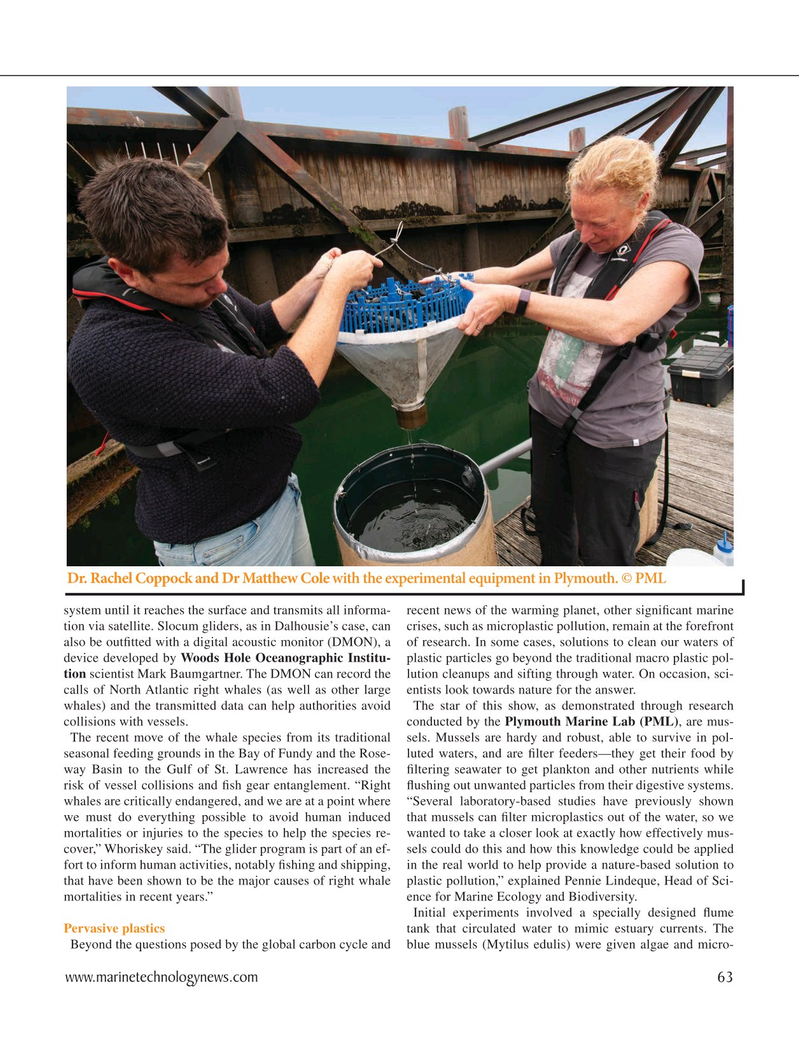
Page 63: of Marine Technology Magazine (September 2021)
MTR100: Focus on 100 Leading Companies, People and Innovations in the Subsea Space
Read this page in Pdf, Flash or Html5 edition of September 2021 Marine Technology Magazine
Dr. Rachel Coppock and Dr Matthew Cole with the experimental equipment in Plymouth. © PML system until it reaches the surface and transmits all informa- recent news of the warming planet, other signi? cant marine tion via satellite. Slocum gliders, as in Dalhousie’s case, can crises, such as microplastic pollution, remain at the forefront also be out? tted with a digital acoustic monitor (DMON), a of research. In some cases, solutions to clean our waters of device developed by Woods Hole Oceanographic Institu- plastic particles go beyond the traditional macro plastic pol- tion scientist Mark Baumgartner. The DMON can record the lution cleanups and sifting through water. On occasion, sci- calls of North Atlantic right whales (as well as other large entists look towards nature for the answer.
whales) and the transmitted data can help authorities avoid The star of this show, as demonstrated through research collisions with vessels. conducted by the Plymouth Marine Lab (PML), are mus-
The recent move of the whale species from its traditional sels. Mussels are hardy and robust, able to survive in pol- seasonal feeding grounds in the Bay of Fundy and the Rose- luted waters, and are ? lter feeders—they get their food by way Basin to the Gulf of St. Lawrence has increased the ? ltering seawater to get plankton and other nutrients while risk of vessel collisions and ? sh gear entanglement. “Right ? ushing out unwanted particles from their digestive systems. whales are critically endangered, and we are at a point where “Several laboratory-based studies have previously shown we must do everything possible to avoid human induced that mussels can ? lter microplastics out of the water, so we mortalities or injuries to the species to help the species re- wanted to take a closer look at exactly how effectively mus- cover,” Whoriskey said. “The glider program is part of an ef- sels could do this and how this knowledge could be applied fort to inform human activities, notably ? shing and shipping, in the real world to help provide a nature-based solution to that have been shown to be the major causes of right whale plastic pollution,” explained Pennie Lindeque, Head of Sci- mortalities in recent years.” ence for Marine Ecology and Biodiversity.
Initial experiments involved a specially designed ? ume
Pervasive plastics tank that circulated water to mimic estuary currents. The
Beyond the questions posed by the global carbon cycle and blue mussels (Mytilus edulis) were given algae and micro- www.marinetechnologynews.com 63
MTR #7 (50-65).indd 63 9/22/2021 4:02:50 PM

 62
62

 64
64
